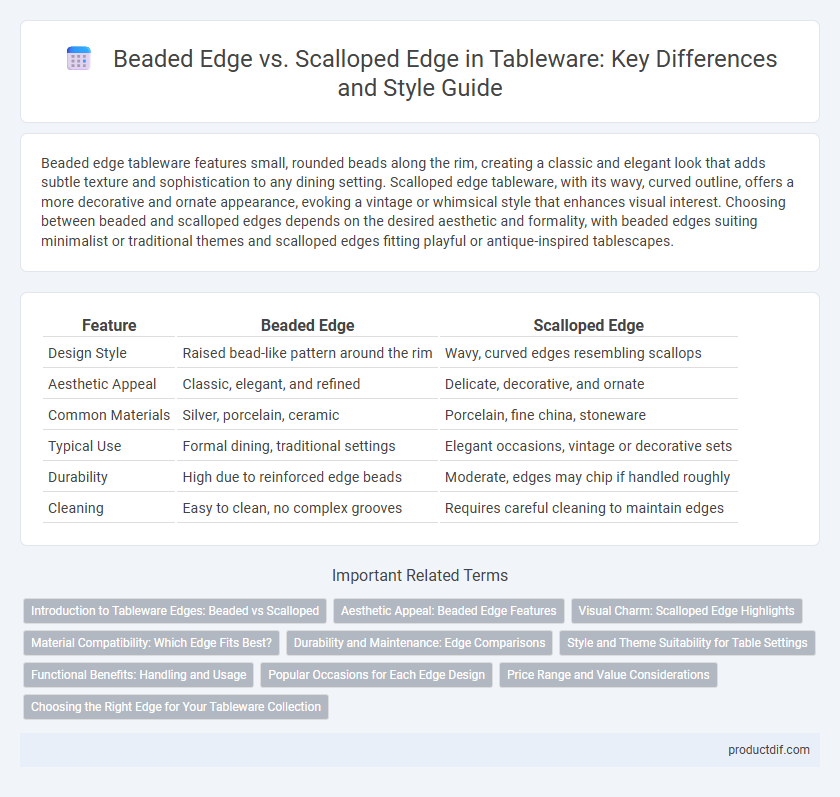Beaded edge tableware features small, rounded beads along the rim, creating a classic and elegant look that adds subtle texture and sophistication to any dining setting. Scalloped edge tableware, with its wavy, curved outline, offers a more decorative and ornate appearance, evoking a vintage or whimsical style that enhances visual interest. Choosing between beaded and scalloped edges depends on the desired aesthetic and formality, with beaded edges suiting minimalist or traditional themes and scalloped edges fitting playful or antique-inspired tablescapes.
Table of Comparison
| Feature | Beaded Edge | Scalloped Edge |
|---|---|---|
| Design Style | Raised bead-like pattern around the rim | Wavy, curved edges resembling scallops |
| Aesthetic Appeal | Classic, elegant, and refined | Delicate, decorative, and ornate |
| Common Materials | Silver, porcelain, ceramic | Porcelain, fine china, stoneware |
| Typical Use | Formal dining, traditional settings | Elegant occasions, vintage or decorative sets |
| Durability | High due to reinforced edge beads | Moderate, edges may chip if handled roughly |
| Cleaning | Easy to clean, no complex grooves | Requires careful cleaning to maintain edges |
Introduction to Tableware Edges: Beaded vs Scalloped
Beaded edge tableware features a subtle row of raised dots around the rim, providing a classic, textured detail that enhances grip and visual interest. Scalloped edge tableware displays a series of smooth, wave-like curves that create an elegant and decorative outline, often used to add sophistication to formal dining settings. Both edge styles influence the overall aesthetic and functionality of plates and bowls, catering to different design preferences and occasions.
Aesthetic Appeal: Beaded Edge Features
Beaded edge tableware features a delicate row of small, rounded beads along the rim, adding a subtle texture that enhances the piece's elegance and refinement. This design element creates a timeless, classic look ideal for formal dining settings and vintage-inspired decor. The precise beading captures light gently, emphasizing craftsmanship and elevating the overall aesthetic appeal of plates, bowls, and serving dishes.
Visual Charm: Scalloped Edge Highlights
Scalloped edges on tableware create a delicate, wave-like pattern that enhances visual charm by adding texture and elegance to each piece. Unlike the uniform symmetry of beaded edges, scalloped edges offer a dynamic, organic appearance that catches light subtly, elevating the overall table setting. This design detail emphasizes sophistication and artistic craftsmanship, making scalloped edge tableware a favorite for formal dining and special occasions.
Material Compatibility: Which Edge Fits Best?
Beaded edge tableware, characterized by raised dots around the rim, is typically crafted from durable materials like bone china and porcelain, making it ideal for formal dining settings and compatible with heavy use and frequent washing. Scalloped edge designs, featuring wavy, curved rims, are often used on stoneware and earthenware, lending a decorative and rustic appeal that suits casual dining and less frequent dishwasher cycles. For optimal material compatibility, beaded edges perform best with fine, resilient ceramics, whereas scalloped edges are more suited to thicker, textured materials.
Durability and Maintenance: Edge Comparisons
Beaded edge tableware features raised, rounded beads that provide extra strength and resistance to chipping, making it highly durable for everyday use. Scalloped edge designs, characterized by their gentle, wavy contours, offer less protection against impact, requiring more careful handling and maintenance to avoid damage. Both styles benefit from regular cleaning, but beaded edges tend to hide wear and tear better, reducing visible signs of aging over time.
Style and Theme Suitability for Table Settings
Beaded edge tableware features a subtle raised bead around the rim, lending a classic and refined look ideal for traditional or vintage-themed table settings. Scalloped edge designs display a wavy, decorative rim that introduces a playful and elegant flair, perfectly complementing garden parties or casual gatherings. Selecting between beaded and scalloped edges enhances the table's overall aesthetic by aligning the style with the intended ambiance and theme.
Functional Benefits: Handling and Usage
Beaded edge tableware provides a textured rim that enhances grip, reducing the risk of slips during handling and making it ideal for both casual and formal dining settings. Scalloped edge designs offer aesthetic appeal while maintaining easy maneuverability, with gentle curves that allow secure handling without sharp or uncomfortable edges. Both edge styles improve user experience by balancing decorative elements with practical functionality for everyday use.
Popular Occasions for Each Edge Design
Beaded edge tableware is favored for formal occasions such as weddings and elegant dinner parties due to its classic and sophisticated appearance. Scalloped edge designs are popular for casual gatherings and festive celebrations, offering a playful and decorative touch. Each edge style enhances the ambiance, aligning with the event's tone and guest experience.
Price Range and Value Considerations
Beaded edge tableware typically falls within a moderate price range, offering a classic, elegant design that enhances durability and long-term value. Scalloped edge pieces often command higher prices due to their intricate detailing and decorative appeal, making them ideal for formal settings but potentially less versatile for everyday use. When considering value, beaded edges provide a balanced investment with timeless style, while scalloped edges prioritize aesthetic impact and uniqueness.
Choosing the Right Edge for Your Tableware Collection
Choosing the right edge for your tableware collection depends on the desired aesthetic and functionality; beaded edges offer a classic, intricate detail that enhances traditional settings, while scalloped edges provide a softer, more decorative touch suited for elegant or vintage-inspired table settings. Beaded edges create a tactile texture that improves grip and durability, making them practical for everyday use, whereas scalloped edges contribute to a refined, ornamental look ideal for formal occasions or special events. Prioritize the overall style and frequency of use to ensure your tableware complements your dining experience and personal taste.
Beaded Edge vs Scalloped Edge Infographic

 productdif.com
productdif.com